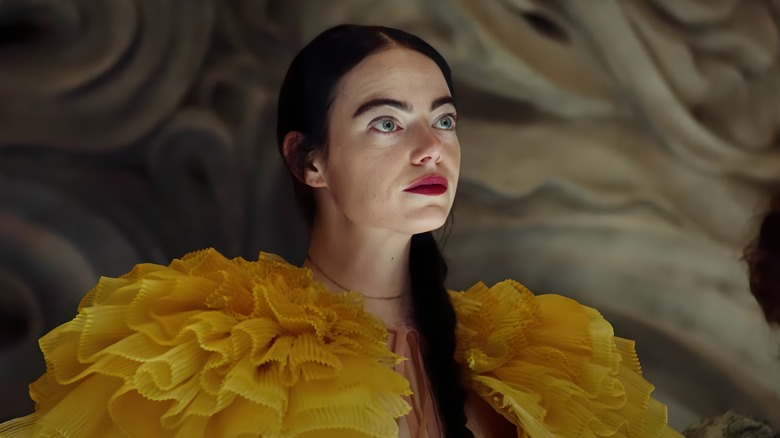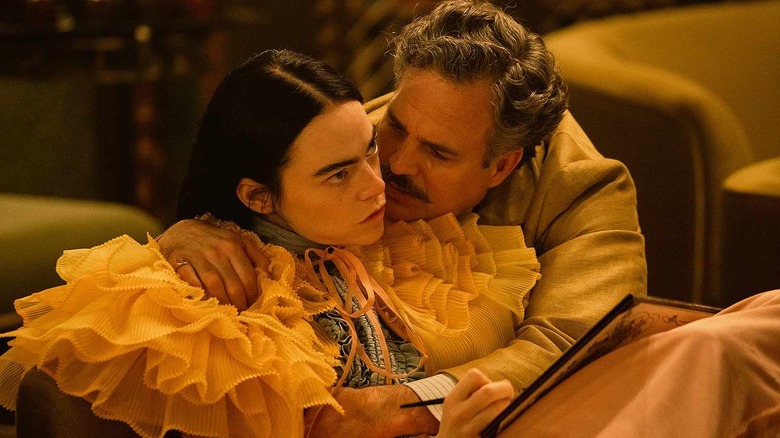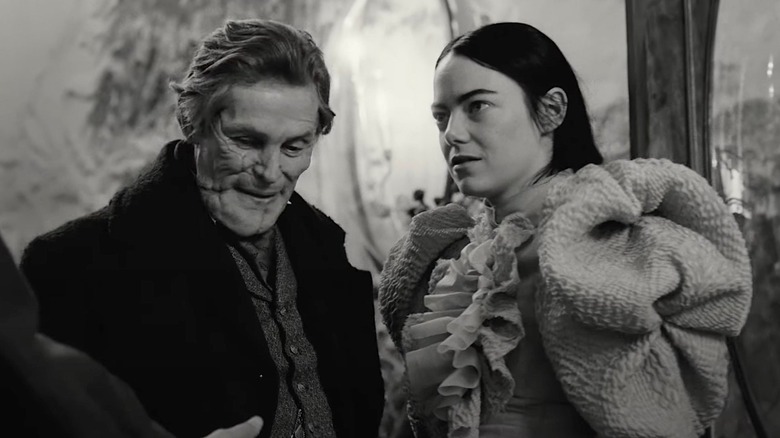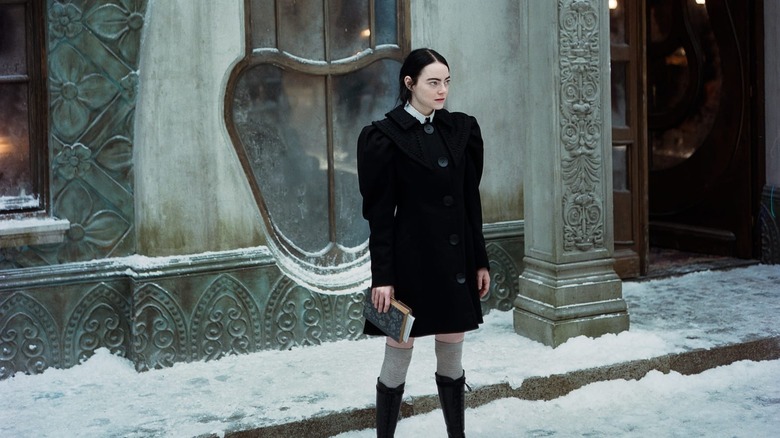How Costuming Creates The World Of Yorgos Lanthimos' Poor Things
Cinematic costumes are an Oscars category that you might have talked over during your most recent watch party, but any fashionista knows that clothes can tell a story just as well as a screenplay. Some films rely on wardrobe for their most memorable moments, like Jennifer Garner's iconic dress from "13 Going on 30," or for defining a character through the years, like Gwenyth Paltrow's green silk in "Great Expectations."
Acclaimed filmmaker Yorgos Lanthimos is no stranger to costume drama, having previously explored the genre with "The Favorite" in 2017. Like his previous film, his forthcoming feature "Poor Things" will star Emma Stone. The pair are both interested in how fashion assists in communicating aspects of a character and the world around them.
In their latest endeavor, costumes were a big consideration. The film is based on a novel of the same name about a drowned girl named Bella who is revived with the brain of an infant by a mad scientist. Although it's set in the 19th century, it delves into a surrealist, ahistorical realm through science fiction. This departure from reality was reflected in the wardrobe, as costumes are often used as a visual indicator to place characters in time.
"Holly Waddington, who did the costumes, and I realized early on that costumes and production design would be a very important part of not only telling this story, but creating a world," the director explained to Vogue in a May 2023 interview.
Lanthimos added that the futuristic elements of the novel encouraged him and Waddington to explore unconventional wardrobe options that weren't necessarily loyal to the period setting. "We looked at materials they used in the '70s and thought about how they would work in a costume, from latex to plastic to all sorts of things," he revealed.
The film's fashion balances history and the future
Using futuristic materials doesn't just confuse the time period, it also plays into the un-reality found in other elements of the film. The trailer alone reveals futuristic cities and palace ruins rising from the ocean, all with colors so vibrant they don't appear real. The film's fashion, too, plays into this theatricality and departure from naturalism, and we see this firsthand via the "house cape" Emma Stone wears at the beginning of the movie. The frou-frou, the ruffles, the shoulder pads, the embellishments — it's nothing short of over the top. The house cape and other offbeat outfit choices early on speak to the character's childlike nature.
"At the start of the film, Bella is being dressed by a maid and is wearing that white silk house cape a lot of the time," Stone explained, "then, once she's set off on her journey, she's dressing herself, so she's wearing bloomers with a jacket and a big hat or whatever, and I loved that element of, 'How would Bella put clothing together with the way her mind works at this point?'"
Costuming plays a large role in telling Bella's story, and her wardrobe develops as rapidly as her mind over the course of the film. As her personhood becomes more defined, she goes from frills to "more structure."
"At the end, there are these very military-looking dresses that look like nothing you've seen Bella wear," the actor revealed. "Things are much more form-fitting and constrained, but that's because she's come to a place where she's grown and decided who she is and what she's going to do. She's not assimilating, necessarily, but there's just more structure there." Interestingly enough, this transition reminded me of Stone's character in "Easy A," who upon reclaiming her sexuality starts dressing in black corsets and brands herself with a scarlet A.
Lanthimos always pays close attention to costumes
The late 19th century was also a constrictive time in terms of manners. Women in high society were expected to follow a strict set of social codes reflected in classic novels of the period like Edith Wharton's "The Age of Innocence." Bella represents a departure from that restriction, someone unbound by shame or societal expectation. Before Bella is worn by the world, she is first totally at odds with it. Her ruffles and silhouettes aren't completely out of place in that time period, but they still manage to illustrate her free-mindedness.
This bears a stark contrast to the restrictive costuming of Yorgos Lanthimos' 2017 film, "The Favourite." When asked how she liked wearing corsets on-set all day for that project, Emma Stone admitted in a September 2018 interview with the Los Angeles Times that "it was an adjustment." But Lanthimos did not favor form over function and was less interested in adhering strictly to the time period than he was in telling a story. He allowed costume designer Sandy Powell to take some ahistorical liberties to create some variety in the wardrobes of the female characters, per a November 2018 interview Powell had with Vogue. In this case, the director was more concerned with naturalism than he was with historical accuracy.
"He didn't want them to move stiffly and uncomfortably," Powell said. "Yorgos wanted the women to be able to roll around on the ground in their corsets and if the clothes got dirty, to leave them dirty."
Stone's character in the 2017 film transforms from wearing basically rags to exorbitant dresses. Still, Powell didn't want the character to perfectly assimilate — just as Bella doesn't totally assimilate in "Poor Things." "After she becomes a lady of the court, I wanted her to look as though she'd gone too far and too over-the-top," Powell noted. "I tried to make her appear a bit vulgar."
Bella's clothes map her journey
Everything that Holly Waddington communicates through her costumes in "Poor Things," from unreality to personal growth, is precisely what drew Emma Stone to the project in the first place. It was the paradoxical relatability and impossibility of this character's journey that the actor found so compelling. As she told Vogue:
"Watching Bella mark that journey of going from such a self-focused kind of pleasure-seeking — whether it was, you know, eating way too many tarts in Lisbon or wanting to experience pleasure in all these different capacities that she learns about while being possessed by men — to wanting to become a doctor and help people in a different way, these lessons that we go through in our lives over a long period of time are happening very quickly for her, and it was such a great opportunity to live an entire life that wasn't marked at all by shame or trauma. "
Yorgos Lanthimos has never been one to underestimate the importance of a good wardrobe department, and this costume drama promises to be another unconventional twist on fashion history and evolving femininity. You can tell a lot about a woman by her clothes, and "Poor Things" is sure to tell you a lot about at least one woman, too.



